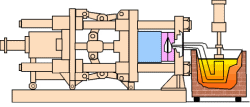The Process of Hot Chamber Zinc Castings
A Hot Chamber machine is especially used for low melting point alloys like magnesium, zinc and copper, which don’t quickly damage metal hot chamber pots, plungers and cylinders. One popular hot chamber process used is the Hot Chamber Zinc Castings process. Because it provides high rate of productivity, more and more companies are using the Hot Chamber Zinc Castings process.
In the process of Hot Chamber Zinc Castings, strips or rods of metal zinc will be melted inside a hot chamber at about 700-800 degrees Fahrenheit. While the zinc metal is inside the hot chamber, the gooseneck, commonly called as the shot sleeve, will be plunged into the hot chamber. Then the molten zinc metal is injected straightly from the hot chamber, inside the pair of die halves that are attached in the Hot Chamber Zinc Castings machine.
After that, the molten zinc metal will be infused with hydraulic pressure inside the pair of die halves. The molten zinc will be held under a high pressure in anticipation of the solidification of the metal. The waiting time is commonly about 15 seconds, but it still depends on the size of the parts. Afterwards, the pair of die halves will be opened and all the parts will be removed either by hand or with the use of a machine. Finishing touches like assembly, chrome plating, anodizing, painting, precision machining, tumble deburring and trimming will be followed.
That’s how the process of Hot Chamber Zinc Castings works. It may look simple but it requires regular monitoring and hard work to produce a perfect material.


